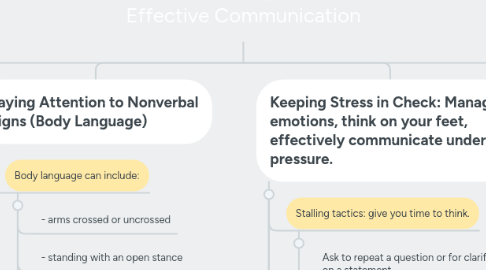
1. Being an Engaged Listener: Focusing less on what you have to say and more on understanding what the other person is saying and feeling.
1.1. Focus Fully on the Speaker
1.1.1. Do not distract yourself with technology or thinking about something else.
1.1.2. Try repeating what the speaker is saying in your head, to help stay focused and reinforce the message.
1.2. Favour Your Right Ear
1.2.1. The left side of the brain processes speech comprehension and emotions. (The left side of the brain is connected to the right side of the body.)
1.3. Avoid Interrupting or Trying to Redirect the Conversation to Your Concerns
1.3.1. By forming what you're going to say next in you brain you won't be focusing on what the person has to say.
1.3.2. Listening is not the same as waiting your turn to speak, don't let the speaker feel that your mind is somewhere else.
1.4. Show Your Interest in What's Being Said
1.4.1. - Nod occasionally
1.4.2. - Smile at the speaker
1.4.3. - Keep an open and inviting posture
1.4.4. - Use small verbal comments ("yes" or "uh huh." This will encourage the speaker.
1.5. Set Aside Judgment
1.5.1. Fully understanding what someone is saying means you must not approach what they are saying with blame and criticism.
1.6. Provide Feedback
1.6.1. Reflect what has been said: "What I'm hearing is," "Sounds like you are saying," "So you mean," "You're saying that."
1.6.2. Do not simply repeat back the exact words. Express what the information means to you.
1.6.3. Clarify points: "Did you mean," "What do you mean by this."
2. Paying Attention to Nonverbal Signs (Body Language)
2.1. Body language can include:
2.1.1. - arms crossed or uncrossed
2.1.2. - standing with an open stance
2.1.3. - sitting at the edge of your set or sitting comfortably
2.1.4. - maintaining eye contact
2.2. Be Aware of Indiviual Differences
2.2.1. Age, culture, religion, gender and emotional state must all be taken into account because each factor can change how someone using body language signals.
2.3. Identify Nonverbal Communication Signals as a Group
2.3.1. Do not overthink one single gesture or nonverbal cue.
2.3.2. Sometimes body language occurs without the person truly meaning it, so it is important to consider signals as a whole.
2.4. Match Nonverbal Signals With Your Words
2.4.1. Saying one thing and having your body language contradict it will make the listener confused and suspect dishonesty.
2.5. Adjust Nonverbal Signals According to the Context
2.5.1. Tone of voice should be different when addressing different people (children, adults, cultural background.) We must do the same for emotional state and cultural background of the other person.
2.6. Avoid Negative Body Language
2.6.1. Body language should be used to convey positive feelings, even when that's not you're experiencing.
2.6.2. Create self-confidence by replacing nervousness by smiling, maintaining eye-contact and delivering firm handshakes.
3. Keeping Stress in Check: Manage emotions, think on your feet, effectively communicate under pressure.
3.1. Stalling tactics: give you time to think.
3.1.1. Ask to repeat a question or for clarification on a statement.
3.2. Pause to collect thoughts: makes you more in control than rushing response.
3.3. Make one point and provide an example.
3.3.1. Keep your response short to keep audience interest. If the reaction is well perceived continue with another points.
3.4. Deliver words clearly, speak clearly, maintain an even tone and keep eye contact. Body language should be relaxed and open.
3.5. Wrap up with a summary, if there is silence afterwards don't fill it by talking.
3.6. Recognize when you're becoming stressed.
3.6.1. Tight muscles or stomach.
3.6.2. Clenched or shaking hands.
3.6.3. Shallow Breath or forgetting to breath.
3.7. Take a moment to calm down.
3.8. Allow your sense to rescue.
3.8.1. Have a peppermint in your mouth.
3.8.2. Use a stressball.
3.8.3. Take deep breaths.
3.8.4. Clench and relax muscles.
3.8.5. Recall a soothing image.
3.9. Look for chances of humour.
3.9.1. Share a joke.
3.9.2. Share an amusing story.
3.10. Be willing to compromise to find a middle ground with the other person or backing off if tensions get to high - to reduce risk.
3.11. Agree to disagree.
3.11.1. Take time away from the situation.
3.11.1.1. Go for a walk.
3.11.1.2. Spend a few minutes meditating.
3.11.1.3. Do physical movement.
3.11.1.4. Find a quiet place.
4. Asserting Yourself: Express your thoughts, feelings and needs in an open and honest way.
4.1. Value yourself and your own opinions, but not in a hostile, aggressive or demanding manner.
4.2. Know your needs and wants and learn to express them, without infringing on others.
4.3. Express negative thoughts, but remain respectful.
4.4. Know your limits and do not allow others to take advantage. Look for alternative outcomes.
4.4.1. Learn to say "no."
4.5. Empathetic Assertion
4.5.1. Convey sensitivity to the other person.
4.5.2. Begin by identifying the person's circumstances, then state view.
4.6. Escalating Assertion (employed when first attempts are not successful)
4.6.1. Outline consequences if your needs are not met.
4.7. Practise Assertiveness to Build Confidence
4.7.1. Practise in low risk situations.
4.7.2. Practise on friends and family.
